
We are celebrating 15 years — and counting — of stories that are deeply researched and deeply felt, that build a historical record of what the city has been.
We are celebrating 15 years — and counting — of stories that are deeply researched and deeply felt, that build a historical record of what the city has been.
Earlier this week, we announced the teams selected to participate in the Re-envisioning Branch Libraries design study, a joint project of The Architectural League and the Center for an Urban Future (CUF). CUF’s ongoing research has demonstrated how branch libraries are serving more New Yorkers in more ways than ever before, yet remain undervalued by policymakers. Over the next few months, the design teams’ work will articulate new architectural, financial, and programmatic possibilities for these essential, neighborhood-based resource centers.
Meeting contemporary demand must go beyond accommodating the full array of services libraries currently provide or proving the need for systematic approaches to investment, design, and maintenance. The challenge requires sophisticated understanding of the resources — human, physical, digital, spatial, and civic — that libraries offer to their users. In the conversation below, Shannon Mattern, a scholar who works on libraries, archives, and media infrastructures, and Nate Hill, Deputy Director of the Chattanooga Public Library, talk about what these resources are, how they are evolving, and what design can contribute to how they are deployed. Mattern’s research has ranged from the role of central libraries in downtown redevelopment plans to new directions in urban data science. Hill’s passion for libraries has taken him around the country, from working in 30 of Brooklyn’s 58 branches to designing digital services for the San Jose Public Library to his current role in a particularly innovative, risk-taking library system in Tennessee. Their conversation touches on precedents of experimentation from around the world as well as experiences from careers spent exploring, questioning, and expanding what libraries can be.
–C.S.
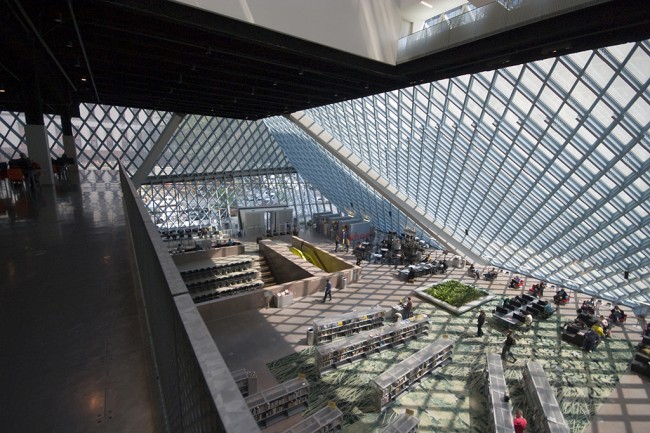
Seattle Public Library, designed by OMA | Photo by Ken Stein
Nate Hill: How did libraries become part of your academic research?
Shannon Mattern: I’ve always been interested in the intersection of media and space, how different media formats occupy space in particular ways and how interfaces have a spatial configuration. I’m interested in the space of the page, the space of the screen, and the ways that architecture can function as media. The construction of space can operate as an integral part of cultivating and communicating the identity of an institution.
In graduate school, I did coursework in urban studies, architectural history, and media studies. When I was looking for a case study for my dissertation, I remember having a conversation with Ray Gastil, the director of the Van Alen Institute at that point, around the time that OMA was chosen to design the Seattle Public Library. We talked about how that project brought together so many of my interests: questions of how to renegotiate the relationship between analog and digital in the allocation of space and the identification of what a library is, questions of the role libraries play in urban redevelopment. It was a great case study. And I realized it was very extendable; that library led me to study other media spaces.
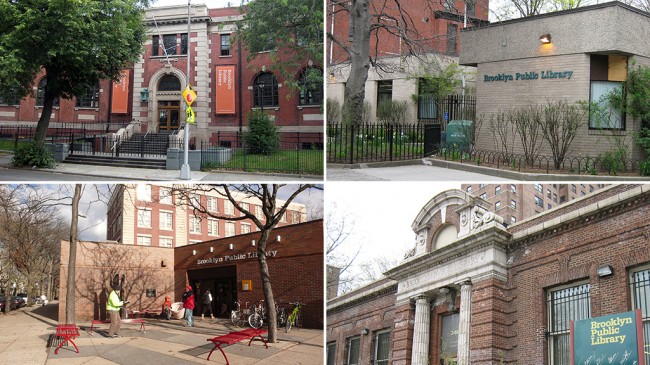
Brooklyn Public Library branches, clockwise from the top left: Williamsburgh, Clinton Hill, Bushwick, Cortelyou | Images via Wally Gobetz, Utopian Branch Library (Clinton Hill and Bushwick), and Sustainable Flatbush
How did you come to work in libraries? What different roles have you held in different systems?
Hill: After I finished art school, I moved straight to New York. I was doing all sorts of odd jobs before I fell into an entry-level job with the Brooklyn Public Library (BPL) system at the Stone Avenue branch in Brownsville. After a few years working in many different roles, I grew increasingly passionate about the work, and I decided to go to the Pratt Institute for my Masters in Library Science. While working towards my degree, I worked in a number of different BPL departments: government affairs, marketing, and in about 30 of Brooklyn’s 58 branches. So I was able to get a very holistic idea of how the library system worked on the ground, while simultaneously doing big visioning projects at Pratt.
One such project was a plan for a library outpost in DUMBO, which, at the time, didn’t have a branch library. It is an isolated community that was changing really quickly. Like many of the Brooklyn neighborhoods that have undergone rapid change, there was a mismatch between where the facilities are located and where the people are. The idea of this outpost was to create services for an underserved community.
The first iPhone had just come out, and we were starting to talk seriously about e-books. The Brooklyn Public Library was using UPS to deliver books to specific branches where users had requested them. It seemed like a great moment to find a storefront space where people could access all the physical materials they wanted by requesting them online. We’d also have magazines and periodicals available and constant programming.
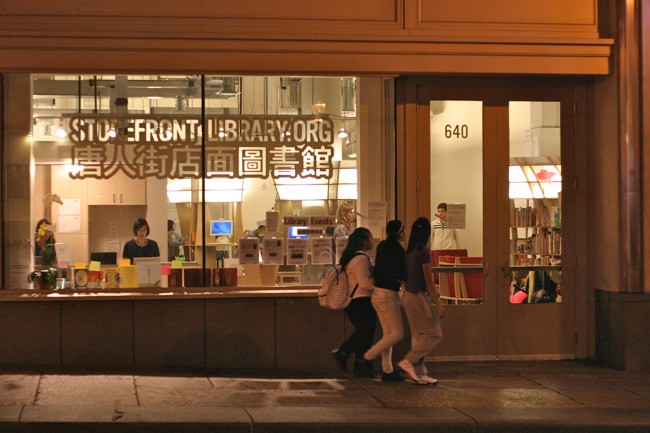
Storefront Library, a temporary library created in Boston’s Chinatown by Street Lab | Photo courtesy of Street Lab
We started talking about where else in Brooklyn this approach might work and how these different outposts — library facilities with no books, just computers and live programming — would differ based on the communities they served.
That project fell through during real estate negotiations. But now you see similar models around the world of agile library service points that aren’t necessarily permanent.
Mattern: Over the past decade we’ve certainly seen examples of real estate developers offering unoccupied storefronts for temporary uses like art shows. And with issues of gentrification on everyone’s mind, neighborhood residents are actively thinking about what kind of culture they want represented on the ground floor, the street level, of their cities. People are aware of the value of having a space where citizens can collaboratively program events amid the nail salons and designer stores.
Where did you go after your time with the Brooklyn Public Library?
Hill: After ten years, I got a job with the San Jose Public Library. I built a new website for that system and, in the process, retrained myself: I had been working in Brooklyn during a time when so many things were moving towards digital, so it seemed logical to become literate in the actual technologies powering this shift.
I spent three years there managing social media and building up the library’s digital services. This kind of work has a broad impact on library users, but I was also interested in having a more direct influence in the organization of a library.
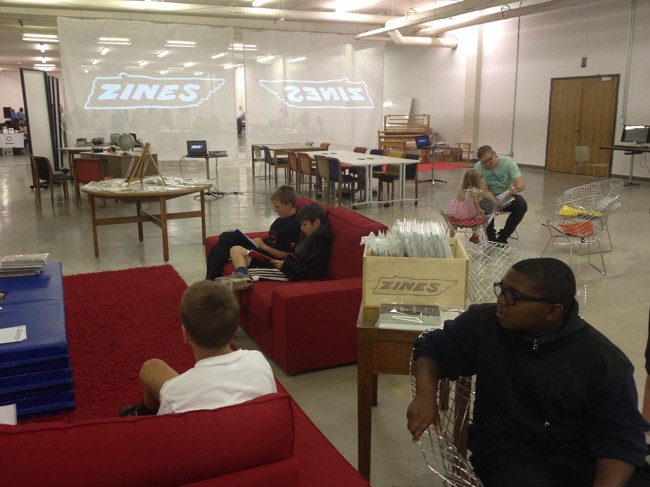
Opening day of Chattanooga’s Zine Library on Chattanooga Public Library’s 4th Floor | Photo via Chattanooga Public Library
I met Corinne Hill (no relation) at an American Library Association conference. She’s the director of the library system here in Chattanooga. It was a no-brainer for me to come to this city to work on what this prototype model for the library of the future might be.
My title is deputy director, so I have the authority, internally and externally, to get things done. And there were two other important factors: Chattanooga has the fastest internet connection in the western hemisphere thanks to its gigabit fiber connection, and there was a junk-filled, 12,000-square-foot space on the fourth floor of the library. When I was in San Jose and Brooklyn, I was basically searching for extra closets where I could try new things! And here is a place with a supportive political climate and a large and underutilized physical space. We like to say that “While traditional library spaces support the consumption of knowledge by offering access to media, the 4th Floor is unique because it supports the production, connection, and sharing of knowledge by offering access to tools and instruction.”
Mattern: That’s interesting. In the branch library design study I’m working on with The Architectural League and the Center for an Urban Future, one of multiple challenges is to “find closets,” which is to say, to make minor modulations in order to offer the kind of access you are able to provide in Chattanooga.
Hill: I know what you mean. But it’s not always about the size of the space. When I talk to other library systems around the country about how they can take on the types of activities that we support here, it’s about making decisions. It’s about observing how library users are actually using the facility and then creating structures to enable those users to engage in the different activities they want to be doing.
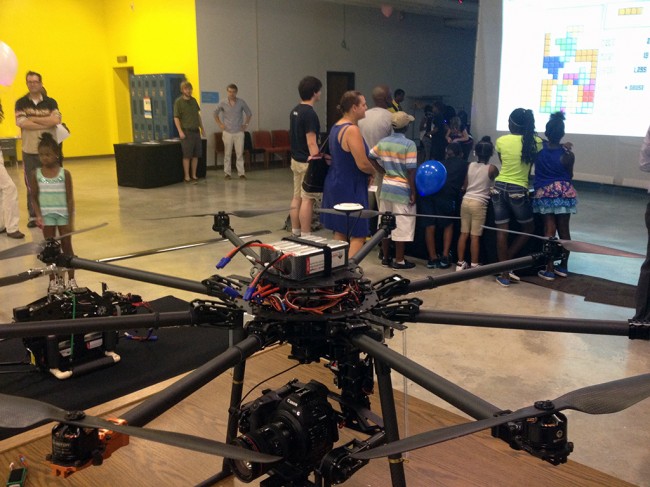
A photography drone during the National Day of Making event at Chattanooga Public Library’s 4th Floor | Image via Chattanooga Public Library
When you look at the branches in New York City, some library advocates like to cite the high circulation statistics as a means of measuring success. But then you see the banks of public computers and how long the wait is to get online. I think there are great opportunities for branch library systems to diversify what public computing is, and to make some hard decisions about how to use your space.
Earlier today I was speaking with a council of local mayors about the work we do at the library and its context within downtown redevelopment. And the ideas that you have written about — the notion of the library as a piece of flexible infrastructure — really resonated with these officials. Your mention of the Rem Koolhaas design for the Seattle Public Library reminds me of an issue of Volume magazine about architecture as a content management system. That was a powerful read for me. Our job is to move information objects around a complex system, and a library user’s view of the data depends on where she is and how the information is being sorted.
Mattern: Over your career in libraries, what have you observed to be the biggest changes to how branch library users access available resources?
Hill: I hear a lot about how browsability and serendipity are essential to the library experience. Personally, I love looking through shelves and stacks. But it’s not an efficient way to use the prime real estate where libraries should ideally be located. Browsing has moved online. In New York as well as here in Chattanooga, I see a huge shift in people wanting to pick up their materials wherever is most convenient to them. If the buildings have fewer stacks of books, those spaces can become community platforms, where people can engage with one another and with the distributed nature of knowledge in that community. The content, the collection, can be sent there.
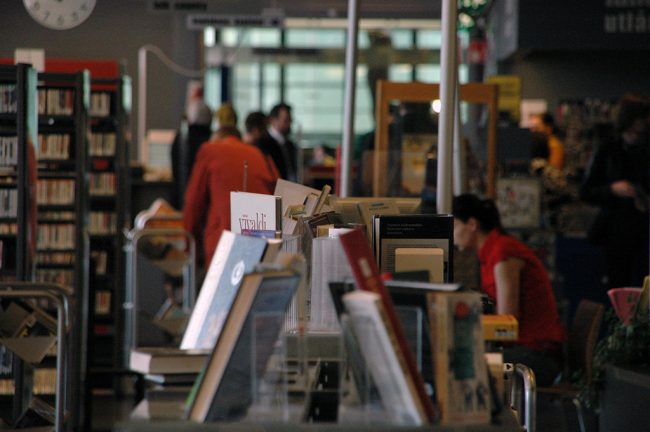
Library 10 in Helsinki | Photo via moqub
Mattern: Besides the collection, what are some of the other resources, newly emerged or newly recognized, that library users want to access?
Hill: The very definition of a library is a pool of shared resources. We tend to think of it as books. But there are also tool-lending libraries and other examples. In Chattanooga, we’ve chosen to focus on making resources available that enable production. The shift from access to media toward access to tools is very interesting. In the ‘90s and early ‘00s, public programming in libraries was considered a loss leader that took up staff time but was useful to attract people to the library that would check out books. We’re seeing this turn around: now access to people and access to knowledge is what we’re about.
What do you think? In your research, do you think these changes of behavior reflect broader patterns in non-school learning, social service delivery, the relationship between digital and physical resources, or other contemporary trends?
It’s not always about renovating the entire building. It’s about how you work within it.Mattern: I do. The contemporary library expands the notion of what users need and what constitutes a resource. There are plenty of metaphors to choose from: platform, infrastructure, etc. Epistemology has changed. Our understanding of what constitutes knowledge is evolving. A lot of people will attribute this to the digital revolution, but I don’t think it’s that simple: for example, traditions of craftsmanship have recognized different types of knowledge acquisition for thousands of years, among them apprenticeships. And today, even in formal institutions, people are realizing that learning isn’t just about “the sage on a stage” or the one definitive text you pull off a library shelf. It’s about making, experimentation, collaboration, multi-sensorial experiences. All of these different kinds of learning can be facilitated by a well-designed space.
In terms of social service delivery, I think the relevant contemporary trends include decreased funding for other types of community services. Libraries are stalwarts, often expected to pick up where other institutions fall short. I just read today about a library system serving food to students in situations when their schools couldn’t provide for their nutritional needs. I think the assumption that we can rely on the library to fill in those gaps is unfair and dangerous.
Hill: I agree. The idea that libraries will somehow fill in for cutbacks in other public institutions is unfortunate. Design is about intention, about setting goals, priorities, and constraints to determine the right services for a community.
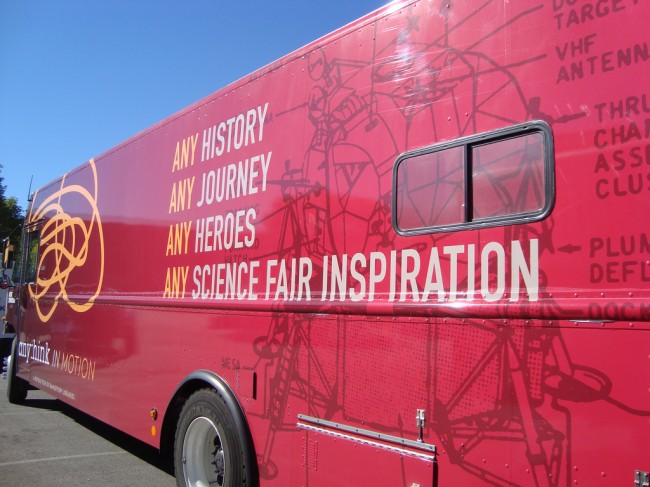
Anythink Library Bookmobile | Photo via Techsoup
Mattern: What do you think are the most exciting approaches to branch library design, programming, and management currently being piloted?
Hill: Looking around the US, most of the excellent libraries in our country are in smaller systems that are able to be more agile. The state of Colorado is filled with good library systems, such as Douglas County or the Rangeview Library District, which rebranded itself “Anythink.”
But we need to figure out how to get this right in our big cities. I think they’re working really hard in Chicago. It’s a massive challenge and very exciting.
I just came back from checking out a fascinating project in Greece, where the Stavros Niarchos Foundation is building a cultural center that will house the national library, an opera house, and a botanical garden. I’ve spent some time checking out branch libraries in Copenhagen; I regularly look to Scandinavia for inspiration.
Aarhus, Denmark, is a good example. One of the smartest things about their project was that they started doing transformation work early on: an iterative process of trying out new services and community engagement techniques in their old building. So by the time that they open this new, incredible space, there won’t be any surprises about the services being provided or how it will be staffed.
In Helsinki, there’s a project called Library 10. In the US, we give a lot of lip service to the idea of co-working in the library. But in Finland, it really works: people come in and use their library cards to check out portable screens and create a work area.
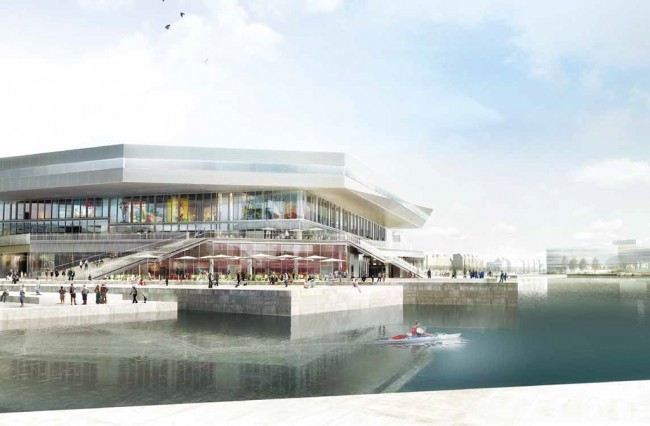
Rendering of Dokk1, Aarhus’s new library and urban media center scheduled for completion at the end of 2014 | Image via Urban Mediaspace Aarhus
Mattern: Different approaches to community engagement in the design process are also important. Examples where designers share mock-ups and actively involve the public in design workshops really do contribute to a sense of community buy-in, as opposed to simply sharing fait accompli plans at town hall meetings and asking, “What do you think?”
There are also some interesting examples from humanitarian design projects that include informal spaces for learning. I’m wary of fetishizing slums and informal urbanism, but there are certainly lessons to be learned from parts of the world beyond Europe and America.
Hill: I agree. There’s no doubt that we can learn from design experiments like the shipping crate libraries in Cape Town. These are examples that I spend a lot of time talking about with library professionals around the world. And sometimes I speak with elected officials who are able to push forward different policies in their cities.
Who else do you think needs to be at the table?
Mattern: I think the social service sector needs to be engaged. Returning to the notion that libraries often pick up slack where other institutions fall short, I think we need to recognize the library as part of an ecosystem of social-cultural knowledge resources. I think the library conversation needs to include university presidents; school superintendents and principals; advocates who deal with affordable housing, recent immigrants, or other disenfranchised populations; real estate developers; and other people with innovative ideas for co-location or partnerships. When I was researching specific libraries, the people who worked the loading docks or pushed the carts around to re-shelve the books often had more insights into how a library building worked than the mayor or the library executives. So we shouldn’t only be engaging figureheads but also learning from the insights of people working on the ground.
Hill: Definitely. And co-location and partnership are essential parts of the conversation. One of our goals with the 4th Floor in Chattanooga is to be the strongest collaborator in town. Without partners, how could we effectively animate 12,000 square feet of space?
Mattern: And what about design? When we talk about making branch libraries better, how much of that challenge can be addressed through their physical sites?
Hill: A lot of it. I really do think that the physical location — an open, public, neutral civic space — is very important. When a municipality tries to close a branch library, the public outcry isn’t because of the books; it’s because of the building.
I think we need to create consistent user experiences between the digital and physical. This is a space design problem: the challenge is to put the right spaces in the right places and making something flexible and sustainable.

Chattanooga Public Library’s 4th Floor | Photo via Chattanooga Public Library
Here in Chattanooga, we’ve learned that it’s not always about renovating the entire building; it’s about how you work within it. Our solutions often involve a lot of duct tape and elbow grease, so to speak. And these are viable solutions. Of course, you can’t avoid talking about leaky roofs, but the organizational and staffing structure has to be part of the solution, part of figuring out how to design the space and how to use it.
The spatial issues tie in with urban planning questions as well: how the library relates to transportation and other components of the city. This isn’t about the library alone: it’s about how it integrates into all of those other services. It’s a wonderfully complex problem.
The views expressed here are those of the authors only and do not reflect the position of The Architectural League of New York.